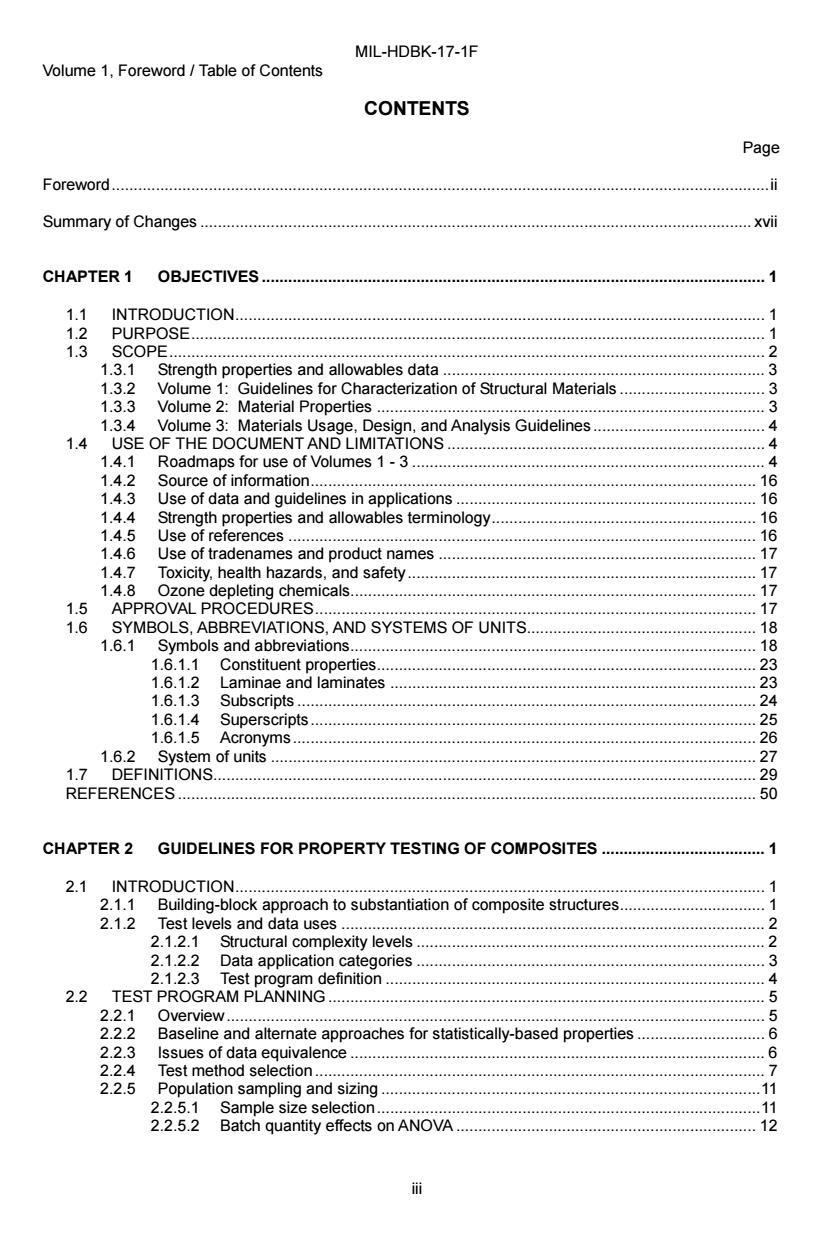
MIL-HDBK-17-1F Volume 1,Foreword Table of Contents CONTENTS Page Foreword. ... Summary of Changes… ......xvii CHAPTER 1 OBJECTIVES.......... 1 1.1 INTRODUCTION… 1.2 PURPOSE 1 .1 1.3 SCOPE .................................................................................... 1.3.1 Strength properties and allowables data....... .3 1.3.2 Volume 1:Guidelines for Characterization of Structural Materials........3 1.3.3 Volume 2:Material Properties........... 03 1.3.4 Volume 3:Materials Usage,Design,and Analysis Guidelines......................................4 1.4 USE OF THE DOCUMENT AND LIMITATIONS...4 1.4.1 Roadmaps for use of Volumes 1-3......4 14.2 Source of information.. 16 1.4.3 Use of data and guidelines in applications.... 16 1.4.4 Strength properties and allowables terminology... 16 1.4.5 Use of references......... 16 1.4.6 Use of tradenames and product names.............. .17 1.4.7 Toxicity,health hazards,and safety. 17 1.4.8 Ozone depleting chemicals................. 17 1.5 APPROVAL PROCEDURES..................... .17 1.6 SYMBOLS,ABBREVIATIONS,AND SYSTEMS OF UNITS. 18 1.6.1 Symbols and abbreviations18 1.6.1.1 Constituent properties.... 23 1.6.1.2 Laminae and laminates...... 23 1.6.1.3 Subscripts.....… 24 1.6.1.4 Superscripts.… 25 1.6.1.5 Acronyms.… .26 1.6.2 System of units.............. 27 1.7 DEFINITIONS... 29 REFERENCES........ ..50 CHAPTER 2 GUIDELINES FOR PROPERTY TESTING OF COMPOSITES.......................... 2.1 INTRODUCTIC0Ni… 2.1.1 Building-block approach to substantiation of composite structures...........................1 2.1.2 Test levels and data uses... 2.1.2.1 Structural complexity levels .......... 2 2.1.2.2 Data application categories..3 2.1.2.3 Test program definition.............. .4 2.2 TEST PROGRAM PLANNING.5 2.2.1 Overview. 2.2.2 5 Baseline and alternate approaches for statistically-based properties.........................6 2.2.3 Issues of data equivalence. 6 2.2.4 Test method selection..... .7 2.2.5 Population sampling and sizing..11 2.2.5.1 Sample size selection...... 2.2.5.2 Batch quantity effects on ANOVA......... .11 .12 讲
MIL-HDBK-17-1F Volume 1, Foreword / Table of Contents iii CONTENTS Page Foreword.....................................................................................................................................................ii Summary of Changes ............................................................................................................................. xvii CHAPTER 1 OBJECTIVES .................................................................................................................. 1 1.1 INTRODUCTION........................................................................................................................ 1 1.2 PURPOSE.................................................................................................................................. 1 1.3 SCOPE....................................................................................................................................... 2 1.3.1 Strength properties and allowables data ......................................................................... 3 1.3.2 Volume 1: Guidelines for Characterization of Structural Materials ................................. 3 1.3.3 Volume 2: Material Properties ........................................................................................ 3 1.3.4 Volume 3: Materials Usage, Design, and Analysis Guidelines....................................... 4 1.4 USE OF THE DOCUMENT AND LIMITATIONS ........................................................................ 4 1.4.1 Roadmaps for use of Volumes 1 - 3 ................................................................................ 4 1.4.2 Source of information..................................................................................................... 16 1.4.3 Use of data and guidelines in applications .................................................................... 16 1.4.4 Strength properties and allowables terminology............................................................ 16 1.4.5 Use of references .......................................................................................................... 16 1.4.6 Use of tradenames and product names ........................................................................ 17 1.4.7 Toxicity, health hazards, and safety............................................................................... 17 1.4.8 Ozone depleting chemicals............................................................................................ 17 1.5 APPROVAL PROCEDURES.................................................................................................... 17 1.6 SYMBOLS, ABBREVIATIONS, AND SYSTEMS OF UNITS.................................................... 18 1.6.1 Symbols and abbreviations............................................................................................ 18 1.6.1.1 Constituent properties...................................................................................... 23 1.6.1.2 Laminae and laminates ................................................................................... 23 1.6.1.3 Subscripts ........................................................................................................ 24 1.6.1.4 Superscripts..................................................................................................... 25 1.6.1.5 Acronyms......................................................................................................... 26 1.6.2 System of units .............................................................................................................. 27 1.7 DEFINITIONS........................................................................................................................... 29 REFERENCES ................................................................................................................................... 50 CHAPTER 2 GUIDELINES FOR PROPERTY TESTING OF COMPOSITES ..................................... 1 2.1 INTRODUCTION........................................................................................................................ 1 2.1.1 Building-block approach to substantiation of composite structures................................. 1 2.1.2 Test levels and data uses ................................................................................................ 2 2.1.2.1 Structural complexity levels ............................................................................... 2 2.1.2.2 Data application categories ............................................................................... 3 2.1.2.3 Test program definition ...................................................................................... 4 2.2 TEST PROGRAM PLANNING ................................................................................................... 5 2.2.1 Overview.......................................................................................................................... 5 2.2.2 Baseline and alternate approaches for statistically-based properties ............................. 6 2.2.3 Issues of data equivalence .............................................................................................. 6 2.2.4 Test method selection ...................................................................................................... 7 2.2.5 Population sampling and sizing ......................................................................................11 2.2.5.1 Sample size selection.......................................................................................11 2.2.5.2 Batch quantity effects on ANOVA .................................................................... 12
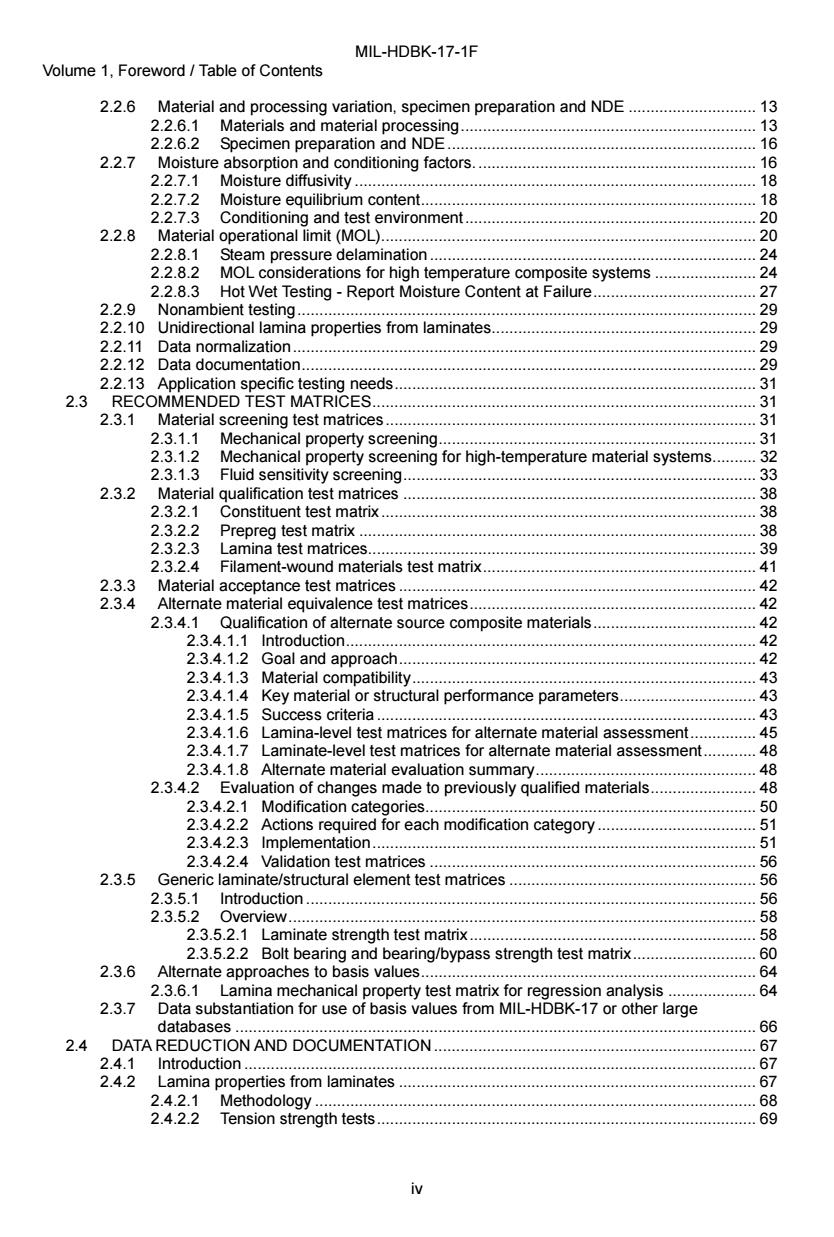
MIL-HDBK-17-1F Volume 1,Foreword Table of Contents 2.2.6 Material and processing variation,specimen preparation and NDE ....13 2.2.6.1 Materials and material processing.. 13 2.2.6.2 Specimen preparation and NDE..... 16 2.2.7 Moisture absorption and conditioning factors......................16 2.2.7.1 Moisture diffusivity 18 2.2.7.2 Moisture equilibrium content..... 18 2.2.7.3 Conditioning and test environment... 20 2.2.8 Material operational limit (MOL). 20 2.2.8.1 Steam pressure delamination.......... 24 2.2.8.2 MOL considerations for high temperature composite systems... 24 2.2.8.3 Hot Wet Testing -Report Moisture Content at Failure................................... 27 2.2.9 Nonambient testing................ 29 2.2.10 Unidirectional lamina properties from laminates.............................................. 29 2.2.11 Data normalization. 29 2.2.12 Data documentation.... 29 2.2.13 Application specific testing needs............... 31 2.3 RECOMMENDED TEST MATRICES...... .31 2.3.1 Material screening test matrices...................... 31 2.3.1.1 Mechanical property screening.............. 31 2.3.1.2 Mechanical property screening for high-temperature material systems..........32 2.3.1.3 Fluid sensitivity screening....33 2.3.2 Material qualification test matrices 38 2.3.2.1 Constituent test matrix. 38 2.3.2.2 Prepreg test matrix.… 38 2.3.2.3 Lamina test matrices.. 39 2.3.2.4 Filament-wound materials test matrix..................... 41 2.3.3 Material acceptance test matrices....... 42 2.3.4 Alternate material equivalence test matrices............. 42 2.3.4.1 Qualification of alternate source composite materials....... 42 2.3.4.1.1 Introduction. 42 2.3.4.1.2 Goal and approach......... 42 2.3.4.1.3 Material compatibility...... 43 2.3.4.1.4 Key material or structural performance parameters...... 43 2.3.4.1.5 Success criteria.................. 43 2.3.4.1.6 Lamina-level test matrices for alternate material assessment............... 5 2.3.4.1.7 Laminate-level test matrices for alternate material assessment............48 2.3.4.1.8 Alternate material evaluation summary...... 48 2.3.4.2 Evaluation of changes made to previously qualified materials.... 48 2.3.4.2.1 Modification categories.......... 50 2.3.4.2.2 Actions required for each modification category......... .51 444 2.3.4.2.3 Implementation...................... 51 2.3.4.2.4 Validation test matrices. 56 2.3.5 Generic laminate/structural element test matrices............................. 56 2.3.5.1 Introduction.. 56 2.3.5.2 Overview....... 58 2.3.5.2.1 Laminate strength test matrix...... 58 2.3.5.2.2 Bolt bearing and bearing/bypass strength test matrix........................... 60 2.3.6 Alternate approaches to basis values............. .64 2.3.6.1 Lamina mechanical property test matrix for regression analysis ................... 64 2.3.7 Data substantiation for use of basis values from MIL-HDBK-17 or other large databaseS..... 66 2.4 DATA REDUCTION AND DOCUMENTATION................... 67 2.4.1 Introduction................. 67 2.4.2 Lamina properties from laminates....... .67 2.4.2.1 Methodology. .68 2.4.2.2 Tension strength tests................... 69 iv
MIL-HDBK-17-1F Volume 1, Foreword / Table of Contents iv 2.2.6 Material and processing variation, specimen preparation and NDE ............................. 13 2.2.6.1 Materials and material processing................................................................... 13 2.2.6.2 Specimen preparation and NDE ...................................................................... 16 2.2.7 Moisture absorption and conditioning factors................................................................ 16 2.2.7.1 Moisture diffusivity ........................................................................................... 18 2.2.7.2 Moisture equilibrium content............................................................................ 18 2.2.7.3 Conditioning and test environment.................................................................. 20 2.2.8 Material operational limit (MOL)..................................................................................... 20 2.2.8.1 Steam pressure delamination .......................................................................... 24 2.2.8.2 MOL considerations for high temperature composite systems ....................... 24 2.2.8.3 Hot Wet Testing - Report Moisture Content at Failure..................................... 27 2.2.9 Nonambient testing........................................................................................................ 29 2.2.10 Unidirectional lamina properties from laminates............................................................ 29 2.2.11 Data normalization......................................................................................................... 29 2.2.12 Data documentation....................................................................................................... 29 2.2.13 Application specific testing needs.................................................................................. 31 2.3 RECOMMENDED TEST MATRICES....................................................................................... 31 2.3.1 Material screening test matrices.................................................................................... 31 2.3.1.1 Mechanical property screening........................................................................ 31 2.3.1.2 Mechanical property screening for high-temperature material systems.......... 32 2.3.1.3 Fluid sensitivity screening................................................................................ 33 2.3.2 Material qualification test matrices ................................................................................ 38 2.3.2.1 Constituent test matrix..................................................................................... 38 2.3.2.2 Prepreg test matrix .......................................................................................... 38 2.3.2.3 Lamina test matrices........................................................................................ 39 2.3.2.4 Filament-wound materials test matrix.............................................................. 41 2.3.3 Material acceptance test matrices ................................................................................. 42 2.3.4 Alternate material equivalence test matrices................................................................. 42 2.3.4.1 Qualification of alternate source composite materials..................................... 42 2.3.4.1.1 Introduction............................................................................................. 42 2.3.4.1.2 Goal and approach................................................................................. 42 2.3.4.1.3 Material compatibility.............................................................................. 43 2.3.4.1.4 Key material or structural performance parameters............................... 43 2.3.4.1.5 Success criteria ...................................................................................... 43 2.3.4.1.6 Lamina-level test matrices for alternate material assessment............... 45 2.3.4.1.7 Laminate-level test matrices for alternate material assessment............ 48 2.3.4.1.8 Alternate material evaluation summary.................................................. 48 2.3.4.2 Evaluation of changes made to previously qualified materials........................ 48 2.3.4.2.1 Modification categories........................................................................... 50 2.3.4.2.2 Actions required for each modification category.................................... 51 2.3.4.2.3 Implementation....................................................................................... 51 2.3.4.2.4 Validation test matrices .......................................................................... 56 2.3.5 Generic laminate/structural element test matrices ........................................................ 56 2.3.5.1 Introduction ...................................................................................................... 56 2.3.5.2 Overview.......................................................................................................... 58 2.3.5.2.1 Laminate strength test matrix................................................................. 58 2.3.5.2.2 Bolt bearing and bearing/bypass strength test matrix............................ 60 2.3.6 Alternate approaches to basis values............................................................................ 64 2.3.6.1 Lamina mechanical property test matrix for regression analysis .................... 64 2.3.7 Data substantiation for use of basis values from MIL-HDBK-17 or other large databases ...................................................................................................................... 66 2.4 DATA REDUCTION AND DOCUMENTATION ......................................................................... 67 2.4.1 Introduction .................................................................................................................... 67 2.4.2 Lamina properties from laminates ................................................................................. 67 2.4.2.1 Methodology .................................................................................................... 68 2.4.2.2 Tension strength tests...................................................................................... 69
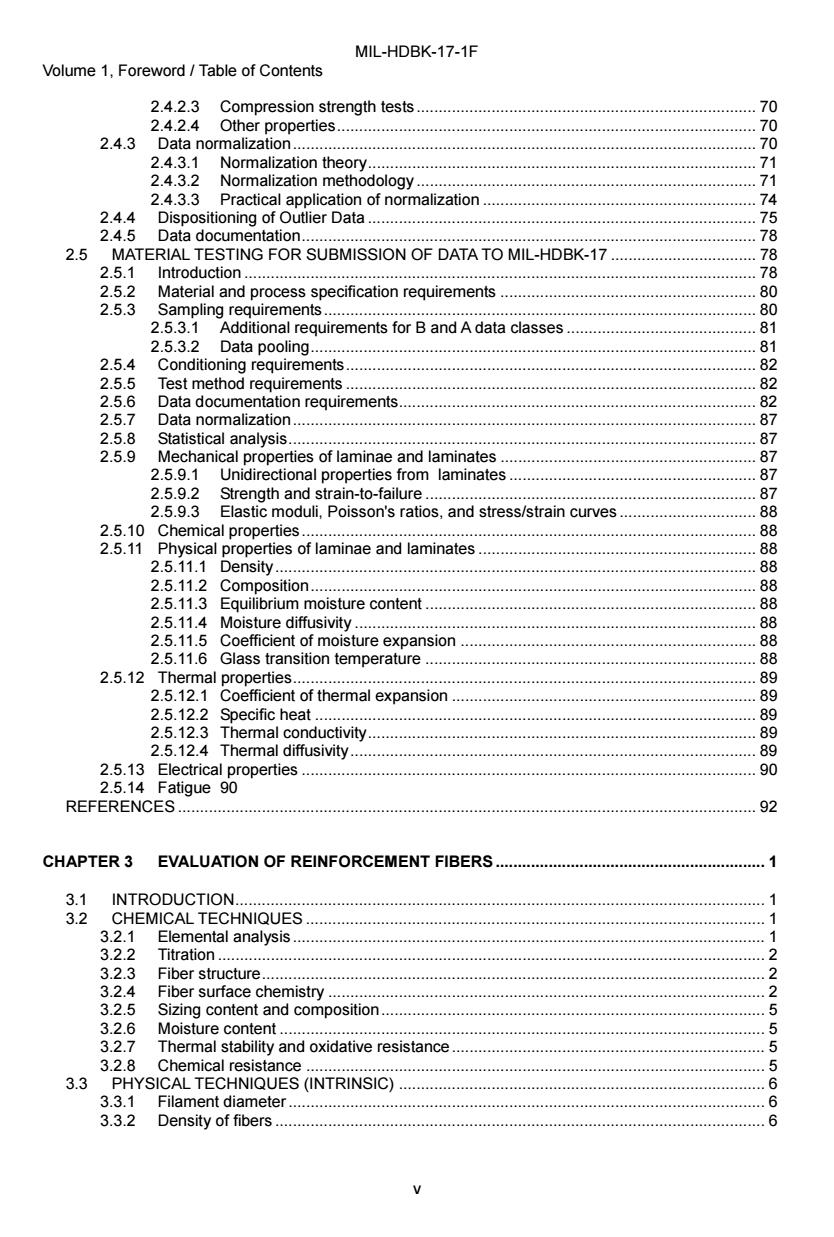
MIL-HDBK-17-1F Volume 1,Foreword Table of Contents 2.4.2.3 Compression strength tests........... 70 2.4.2.4 Other properties... 70 2.4.3 Data normalization.............. 70 2.4.3.1 Normalization theory........................... .71 2.4.3.2 Normalization methodology.71 2.4.3.3 Practical application of normalization............. 74 2.4.4 Dispositioning of Outlier Data... 75 2.4.5 Data documentation.... 78 2.5 MATERIAL TESTING FOR SUBMISSION OF DATA TO MIL-HDBK-17.................................78 2.5.1 Introduction ............ 78 2.5.2 Material and process specification requirements................................. 80 2.5.3 Sampling requirements............... 80 2.5.3.1 Additional requirements for B and A data classes......................................81 2.5.3.2Dat泊p00ling… 81 2.5.4 Conditioning requirements.... 82 2.5.5 Test method requirements........ 44444444444444 82 2.5.6 Data documentation requirements........ ..82 2.5.7 Data normalization..87 2.5.8 Statistical analysis. 7 2.5.9 Mechanical properties of laminae and laminates..................................87 2.5.9.1 Unidirectional properties from laminates............................................87 2.5.9.2 Strength and strain-to-failure...... 87 2.5.9.3 Elastic moduli,Poisson's ratios,and stress/strain curves............................ 88 2.5.10 Chemical properties...... 88 2.5.11 Physical properties of laminae and laminates 88 2.5.11.1 Density...... 88 2.5.11.2C0mp0siti0n......... 88 2.5.11.3 Equilibrium moisture content. 88 2.5.11.4 Moisture diffusivity............... 88 2.5.11.5 Coefficient of moisture expansion ................................... 88 2.5.11.6 Glass transition temperature..... 88 2.5.12 Thermal properties....... 89 2.5.12.1 Coefficient of thermal expansion... 89 2.5.12.2 Specific heat. 89 2.5.12.3 Thermal conductivity 89 2.5.12.4 Thermal diffusivity............... 89 2.5.13 Electrical properties 90 2.5.14 Fatigue 90 REFERENCES. .92 CHAPTER 3 EVALUATION OF REINFORCEMENT FIBERS........1 3.1 INTRODUCTION............ 32CHEMICAL TECHNIQUES 3.2.1 Elemental analysis.......................... .1 3.2.2 Titration... 2 3.2.3 Fiber structure.… 2 3.2.4 Fiber surface chemistry .................... .2 3.2.5 Sizing content and composition...... 5 3.2.6 Moisture content....... 3.2.7 Thermal stability and oxidative resistance....... .5 3.2.8 Chemical resistance 3.3 PHYSICAL TECHNIQUES (INTRINSIC) .6 3.3.1 Filament diameter.... 。。 6 3.3.2 Density of fibers........ .6
MIL-HDBK-17-1F Volume 1, Foreword / Table of Contents v 2.4.2.3 Compression strength tests............................................................................. 70 2.4.2.4 Other properties............................................................................................... 70 2.4.3 Data normalization......................................................................................................... 70 2.4.3.1 Normalization theory........................................................................................ 71 2.4.3.2 Normalization methodology............................................................................. 71 2.4.3.3 Practical application of normalization .............................................................. 74 2.4.4 Dispositioning of Outlier Data ........................................................................................ 75 2.4.5 Data documentation....................................................................................................... 78 2.5 MATERIAL TESTING FOR SUBMISSION OF DATA TO MIL-HDBK-17 ................................. 78 2.5.1 Introduction .................................................................................................................... 78 2.5.2 Material and process specification requirements .......................................................... 80 2.5.3 Sampling requirements.................................................................................................. 80 2.5.3.1 Additional requirements for B and A data classes ........................................... 81 2.5.3.2 Data pooling..................................................................................................... 81 2.5.4 Conditioning requirements............................................................................................. 82 2.5.5 Test method requirements ............................................................................................. 82 2.5.6 Data documentation requirements................................................................................. 82 2.5.7 Data normalization......................................................................................................... 87 2.5.8 Statistical analysis.......................................................................................................... 87 2.5.9 Mechanical properties of laminae and laminates .......................................................... 87 2.5.9.1 Unidirectional properties from laminates ........................................................ 87 2.5.9.2 Strength and strain-to-failure ........................................................................... 87 2.5.9.3 Elastic moduli, Poisson's ratios, and stress/strain curves ............................... 88 2.5.10 Chemical properties....................................................................................................... 88 2.5.11 Physical properties of laminae and laminates ............................................................... 88 2.5.11.1 Density............................................................................................................. 88 2.5.11.2 Composition..................................................................................................... 88 2.5.11.3 Equilibrium moisture content ........................................................................... 88 2.5.11.4 Moisture diffusivity ........................................................................................... 88 2.5.11.5 Coefficient of moisture expansion ................................................................... 88 2.5.11.6 Glass transition temperature ........................................................................... 88 2.5.12 Thermal properties......................................................................................................... 89 2.5.12.1 Coefficient of thermal expansion ..................................................................... 89 2.5.12.2 Specific heat .................................................................................................... 89 2.5.12.3 Thermal conductivity........................................................................................ 89 2.5.12.4 Thermal diffusivity............................................................................................ 89 2.5.13 Electrical properties ....................................................................................................... 90 2.5.14 Fatigue 90 REFERENCES ................................................................................................................................... 92 CHAPTER 3 EVALUATION OF REINFORCEMENT FIBERS ............................................................. 1 3.1 INTRODUCTION........................................................................................................................ 1 3.2 CHEMICAL TECHNIQUES ........................................................................................................ 1 3.2.1 Elemental analysis........................................................................................................... 1 3.2.2 Titration ............................................................................................................................ 2 3.2.3 Fiber structure.................................................................................................................. 2 3.2.4 Fiber surface chemistry ................................................................................................... 2 3.2.5 Sizing content and composition....................................................................................... 5 3.2.6 Moisture content .............................................................................................................. 5 3.2.7 Thermal stability and oxidative resistance....................................................................... 5 3.2.8 Chemical resistance ........................................................................................................ 5 3.3 PHYSICAL TECHNIQUES (INTRINSIC) ................................................................................... 6 3.3.1 Filament diameter ............................................................................................................ 6 3.3.2 Density of fibers ............................................................................................................... 6
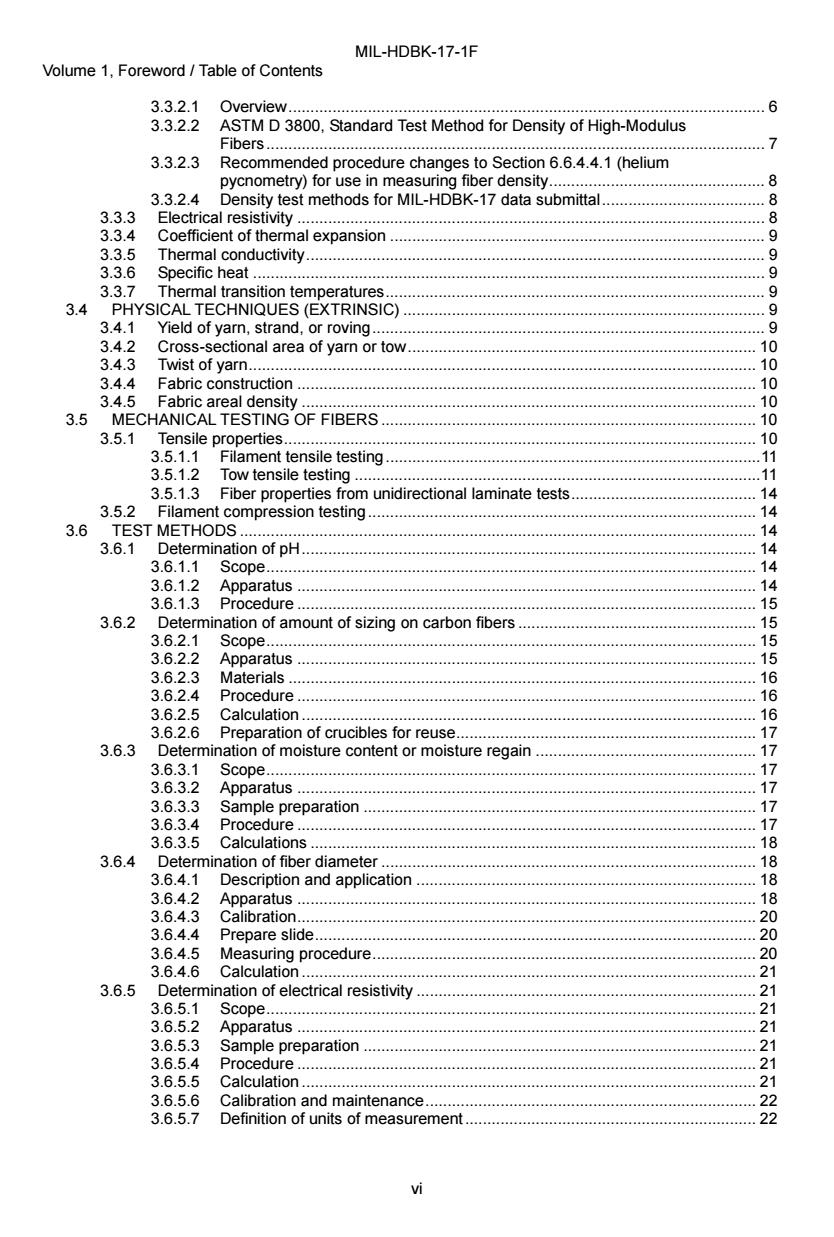
MIL-HDBK-17-1F Volume 1,Foreword Table of Contents 3.3.2.1 Overview.......... ..6 3.3.2.2 ASTM D 3800,Standard Test Method for Density of High-Modulus Fibers........ Recommended procedure changes to Section 6.6.4.4.1(helium 7 3.3.2.3 pycnometry)for use in measuring fiber density...................................8 3.3.2.4 Density test methods for MIL-HDBK-17 data submittal.............. 8 3.3.3 8 Electrical resistivity.. 3.3.4 Coefficient of thermal expansion............. 9 3.3.5 Thermal conductivity... 9 3.3.6 Specific heat.... 9 3.3.7 Thermal transition temperatures........... 9 3.4 PHYSICAL TECHNIQUES (EXTRINSIC).... 9 3.4.1 Yield of yarn,strand,or roving................ .9 3.4.2 Cross-sectional area of yarn or tow.................................................................... 10 3.4.3 Twist of yarn..... 10 3.4.4 Fabric construction.......... 10 3.4.5 Fabric areal density.. 10 3.5 MECHANICAL TESTING OF FIBERS..................... 10 3.5.1 Tensile properties. 10 3.5.1.1 Filament tensile testing....................... 0.11 3.5.1.2 Tow tensile testing… .11 3.5.1.3 Fiber properties from unidirectional laminate tests. 14 3.5.2 Filament compression testing.. 14 3.6 TEST METHODS..... 14 3.6.1 Determination of pH........... 4 3.6.1.1 Scope..... .14 3.6.1.2 Apparatus ....14 3.6.1.3 Procedure.… 15 3.6.2 Determination of amount of sizing on carbon fibers 15 3.6.2.1 SC0pe… 15 3.6.2.2 Apparatus 15 3.6.2.3 Materials 16 3.6.2.4 Procedure... 16 3.6.2.5 Calculation........... 16 3.6.2.6 Preparation of crucibles for reuse. 3.6.3 Determination of moisture content or moisture regain................................................17 3.6.3.1 17 00000600101010000040400000000044000001004014040410000000044400000440040000000000004040000000040 3.6.3.2 Apparatus 1 3.6.3.3 Sample preparation ................ 17 3.6.3.4 Procedure..... 17 44 3.6.3.5 Calculations.… 18 3.6.4 Determination of fiber diameter. 18 3.6.4.1 Description and application....... 18 3.6.4.2 Apparatus 18 3.6.4.3 Calibration.... 20 3.6.4.4 Prepare slide....... 20 3.6.4.5 Measuring procedure.......... 20 3.6.4.6 Calculation....... 21 3.6.5 Determination of electrical resistivity 21 3.6.5.1 SC0pe....... 21 3.6.5.2 Apparatus.… 21 3.6.5.3 Sample preparation.… 21 3.6.5.4 Procedure..… 21 3.6.5.5 Calculation..... 21 3.6.5.6 Calibration and maintenance........ 22 3.6.5.7 Definition of units of measurement... 22 vi
MIL-HDBK-17-1F Volume 1, Foreword / Table of Contents vi 3.3.2.1 Overview............................................................................................................ 6 3.3.2.2 ASTM D 3800, Standard Test Method for Density of High-Modulus Fibers................................................................................................................. 7 3.3.2.3 Recommended procedure changes to Section 6.6.4.4.1 (helium pycnometry) for use in measuring fiber density................................................. 8 3.3.2.4 Density test methods for MIL-HDBK-17 data submittal..................................... 8 3.3.3 Electrical resistivity .......................................................................................................... 8 3.3.4 Coefficient of thermal expansion ..................................................................................... 9 3.3.5 Thermal conductivity........................................................................................................ 9 3.3.6 Specific heat .................................................................................................................... 9 3.3.7 Thermal transition temperatures...................................................................................... 9 3.4 PHYSICAL TECHNIQUES (EXTRINSIC) .................................................................................. 9 3.4.1 Yield of yarn, strand, or roving......................................................................................... 9 3.4.2 Cross-sectional area of yarn or tow............................................................................... 10 3.4.3 Twist of yarn................................................................................................................... 10 3.4.4 Fabric construction ........................................................................................................ 10 3.4.5 Fabric areal density ....................................................................................................... 10 3.5 MECHANICAL TESTING OF FIBERS ..................................................................................... 10 3.5.1 Tensile properties........................................................................................................... 10 3.5.1.1 Filament tensile testing.....................................................................................11 3.5.1.2 Tow tensile testing ............................................................................................11 3.5.1.3 Fiber properties from unidirectional laminate tests.......................................... 14 3.5.2 Filament compression testing........................................................................................ 14 3.6 TEST METHODS ..................................................................................................................... 14 3.6.1 Determination of pH....................................................................................................... 14 3.6.1.1 Scope............................................................................................................... 14 3.6.1.2 Apparatus ........................................................................................................ 14 3.6.1.3 Procedure ........................................................................................................ 15 3.6.2 Determination of amount of sizing on carbon fibers ...................................................... 15 3.6.2.1 Scope............................................................................................................... 15 3.6.2.2 Apparatus ........................................................................................................ 15 3.6.2.3 Materials .......................................................................................................... 16 3.6.2.4 Procedure ........................................................................................................ 16 3.6.2.5 Calculation ....................................................................................................... 16 3.6.2.6 Preparation of crucibles for reuse.................................................................... 17 3.6.3 Determination of moisture content or moisture regain .................................................. 17 3.6.3.1 Scope............................................................................................................... 17 3.6.3.2 Apparatus ........................................................................................................ 17 3.6.3.3 Sample preparation ......................................................................................... 17 3.6.3.4 Procedure ........................................................................................................ 17 3.6.3.5 Calculations ..................................................................................................... 18 3.6.4 Determination of fiber diameter ..................................................................................... 18 3.6.4.1 Description and application ............................................................................. 18 3.6.4.2 Apparatus ........................................................................................................ 18 3.6.4.3 Calibration........................................................................................................ 20 3.6.4.4 Prepare slide.................................................................................................... 20 3.6.4.5 Measuring procedure....................................................................................... 20 3.6.4.6 Calculation ....................................................................................................... 21 3.6.5 Determination of electrical resistivity ............................................................................. 21 3.6.5.1 Scope............................................................................................................... 21 3.6.5.2 Apparatus ........................................................................................................ 21 3.6.5.3 Sample preparation ......................................................................................... 21 3.6.5.4 Procedure ........................................................................................................ 21 3.6.5.5 Calculation ....................................................................................................... 21 3.6.5.6 Calibration and maintenance........................................................................... 22 3.6.5.7 Definition of units of measurement.................................................................. 22
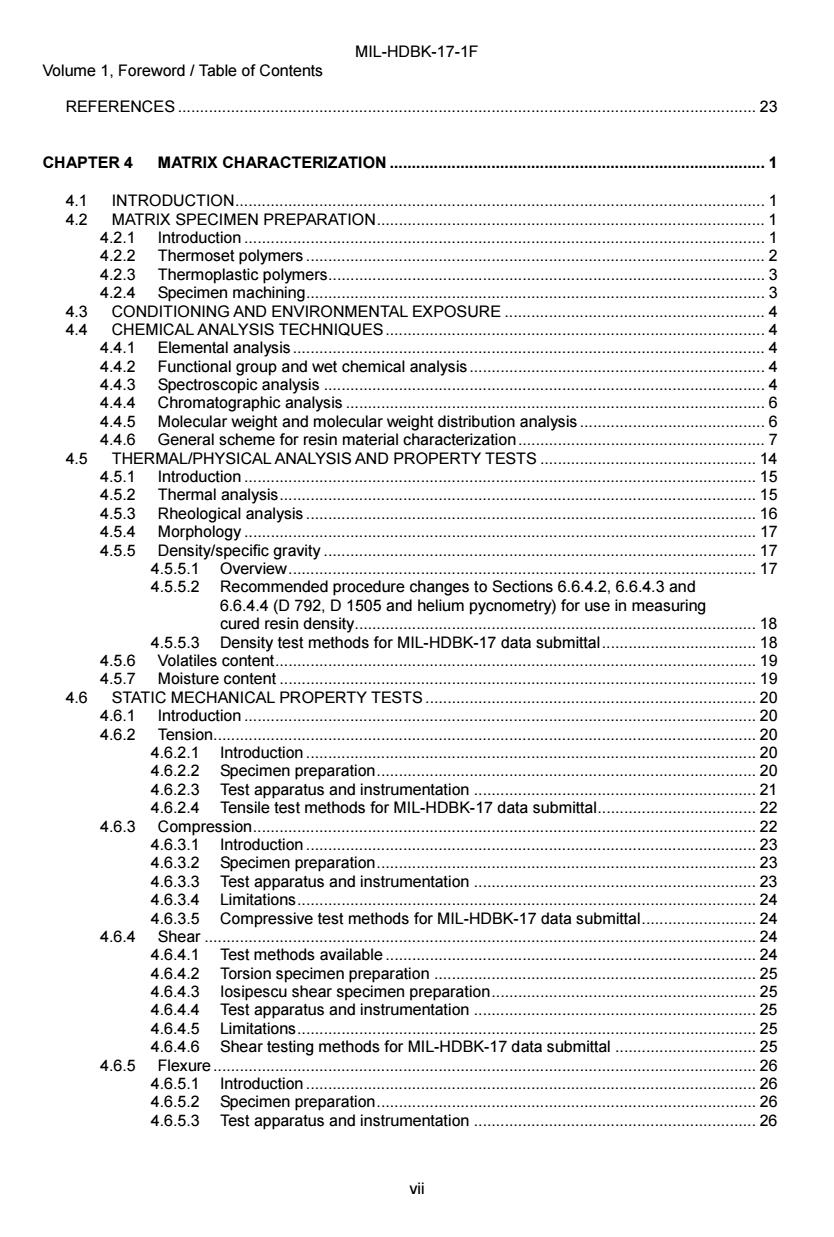
MIL-HDBK-17-1F Volume 1,Foreword Table of Contents REFERENCES 23 CHAPTER 4 MATRIX CHARACTERIZATION.......... 4.1 INTRODUCTION...... 4.2 MATRIX SPECIMEN PREPARATION...................... 1 4.2.1 1 4.2.2 Thermoset polymers................................. . 4.2.3 Thermoplastic polymers..... 3 4.2.4 Specimen machining.... 3 4.3 CONDITIONING AND ENVIRONMENTAL EXPOSURE 4 4.4 CHEMICAL ANALYSIS TECHNIQUES....... 4.4.1 Elemental analysis.......... 4.4.2 Functional group and wet chemical analysis. 4 4.4.3 Spectroscopic analysis... 0.4 4.4.4 Chromatographic analysis................. .6 4.4.5 Molecular weight and molecular weight distribution analysis........ .6 4.4.6 General scheme for resin material characterization... 45 THERMAL/PHYSICAL ANALYSIS AND PROPERTY TESTS 14 4.5.1 Introduction........ 15 4.5.2 Thermal analysis....... 15 4.5.3 Rheological analysis. .16 4.5.4 Morphology. 17 4.5.5 Density/specific gravity... 17 4.5.5.1 Overview.......... 17 4.5.5.2 Recommended procedure changes to Sections 6.6.4.2,6.6.4.3 and 6.6.4.4(D 792,D 1505 and helium pycnometry)for use in measuring cured resin density........... 18 4.5.5.3 Density test methods for MIL-HDBK-17 data submittal............................ 18 4.5.6 Volatiles content 19 4.5.7 Moisture content..... 19 4.6 STATIC MECHANICAL PROPERTY TESTS.............................................. 20 4.6.1 Introduction.. 20 4.6.2 Tension............. 20 4.6.2.1 Introduction..... 20 4.6.2.2 Specimen preparation.. 20 4.6.2.3 Test apparatus and instrumentation 21 4.6.2.4 Tensile test methods for MIL-HDBK-17 data submittal 22 4.6.3 22 4.6.3.1 Introduction...... 23 4.6.3.2 Specimen preparation..... 23 4.6.3.3 Test apparatus and instrumentation.. 23 4.6.3.4 Limitations........................... 24 4.6.3.5 Compressive test methods for MIL-HDBK-17 data submittal.......................... 24 4.6.4 Shear… 24 4.6.4.1 Test methods available. 24 4.6.4.2 Torsion specimen preparation...... 25 4.6.4.3 losipescu shear specimen preparation..................... 25 4.6.4.4 Test apparatus and instrumentation...... 25 4.6.4.5 Limitations........ 25 4.6.4.6 Shear testing methods for MIL-HDBK-17 data submittal .............................. 25 4.6.5 Flexure 26 4.6.5.1 Introduction......... 26 4.6.5.2 Specimen preparation...... 26 4.6.5.3 Test apparatus and instrumentation 26 vii
MIL-HDBK-17-1F Volume 1, Foreword / Table of Contents vii REFERENCES ................................................................................................................................... 23 CHAPTER 4 MATRIX CHARACTERIZATION ..................................................................................... 1 4.1 INTRODUCTION........................................................................................................................ 1 4.2 MATRIX SPECIMEN PREPARATION........................................................................................ 1 4.2.1 Introduction ...................................................................................................................... 1 4.2.2 Thermoset polymers ........................................................................................................ 2 4.2.3 Thermoplastic polymers................................................................................................... 3 4.2.4 Specimen machining........................................................................................................ 3 4.3 CONDITIONING AND ENVIRONMENTAL EXPOSURE ........................................................... 4 4.4 CHEMICAL ANALYSIS TECHNIQUES...................................................................................... 4 4.4.1 Elemental analysis........................................................................................................... 4 4.4.2 Functional group and wet chemical analysis................................................................... 4 4.4.3 Spectroscopic analysis .................................................................................................... 4 4.4.4 Chromatographic analysis ............................................................................................... 6 4.4.5 Molecular weight and molecular weight distribution analysis.......................................... 6 4.4.6 General scheme for resin material characterization........................................................ 7 4.5 THERMAL/PHYSICAL ANALYSIS AND PROPERTY TESTS ................................................. 14 4.5.1 Introduction .................................................................................................................... 15 4.5.2 Thermal analysis............................................................................................................ 15 4.5.3 Rheological analysis ...................................................................................................... 16 4.5.4 Morphology .................................................................................................................... 17 4.5.5 Density/specific gravity .................................................................................................. 17 4.5.5.1 Overview.......................................................................................................... 17 4.5.5.2 Recommended procedure changes to Sections 6.6.4.2, 6.6.4.3 and 6.6.4.4 (D 792, D 1505 and helium pycnometry) for use in measuring cured resin density........................................................................................... 18 4.5.5.3 Density test methods for MIL-HDBK-17 data submittal................................... 18 4.5.6 Volatiles content............................................................................................................. 19 4.5.7 Moisture content ............................................................................................................ 19 4.6 STATIC MECHANICAL PROPERTY TESTS ........................................................................... 20 4.6.1 Introduction .................................................................................................................... 20 4.6.2 Tension........................................................................................................................... 20 4.6.2.1 Introduction ...................................................................................................... 20 4.6.2.2 Specimen preparation...................................................................................... 20 4.6.2.3 Test apparatus and instrumentation ................................................................ 21 4.6.2.4 Tensile test methods for MIL-HDBK-17 data submittal.................................... 22 4.6.3 Compression.................................................................................................................. 22 4.6.3.1 Introduction ...................................................................................................... 23 4.6.3.2 Specimen preparation...................................................................................... 23 4.6.3.3 Test apparatus and instrumentation ................................................................ 23 4.6.3.4 Limitations........................................................................................................ 24 4.6.3.5 Compressive test methods for MIL-HDBK-17 data submittal.......................... 24 4.6.4 Shear ............................................................................................................................. 24 4.6.4.1 Test methods available .................................................................................... 24 4.6.4.2 Torsion specimen preparation ......................................................................... 25 4.6.4.3 Iosipescu shear specimen preparation............................................................ 25 4.6.4.4 Test apparatus and instrumentation ................................................................ 25 4.6.4.5 Limitations........................................................................................................ 25 4.6.4.6 Shear testing methods for MIL-HDBK-17 data submittal ................................ 25 4.6.5 Flexure........................................................................................................................... 26 4.6.5.1 Introduction ...................................................................................................... 26 4.6.5.2 Specimen preparation...................................................................................... 26 4.6.5.3 Test apparatus and instrumentation ................................................................ 26
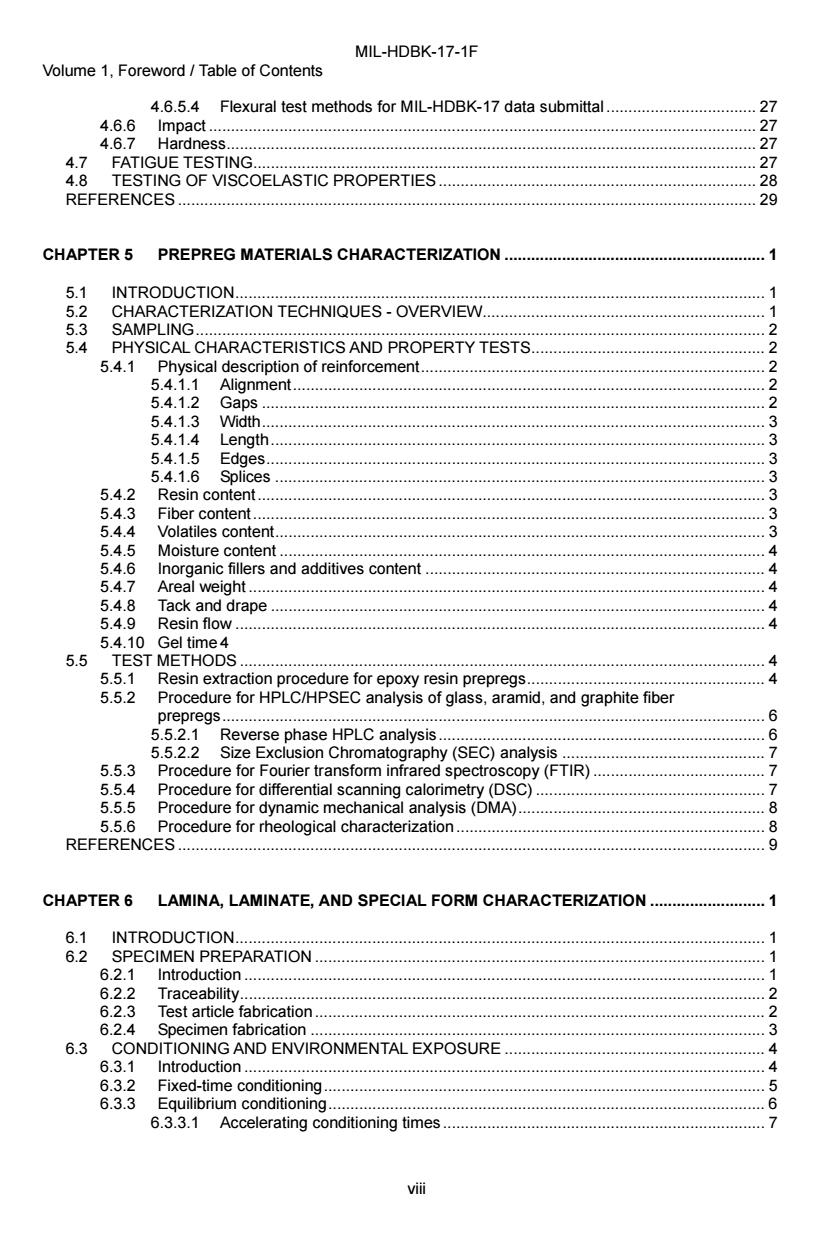
MIL-HDBK-17-1F Volume 1,Foreword Table of Contents 4.6.5.4 Flexural test methods for MIL-HDBK-17 data submittal............................27 4.6.6 27 mD泊C.444a444 4.6.7 Hardness..... 27 4.7 FATIGUE TESTING...... 27 4.8 TESTING OF VISCOELASTIC PROPERTIES 28 REFERENCES............. 29 CHAPTER 5 PREPREG MATERIALS CHARACTERIZATION............. 01 5.1 INTRODUCTION.... .1 5.2 CHARACTERIZATION TECHNIQUES-OVERVIEW... 1 5.3 SAMPLING... 2 5.4 PHYSICAL CHARACTERISTICS AND PROPERTY TESTS. 5.4.1 Physical description of reinforcement. 2 5.4.1.1 Alignment. 2 5.4.1.2 GapS.… 5.4.1.3 Width..... 3 5.4.1.4 Length.... 3 5.4.1.5 Edges.… 3 5.4.1.6 Splices 3 5.4.2 Resin content..… 3 5.4.3 Fiber content.… 5.4.4 Volatiles content… 3 5.4.5 Moisture content... 4 5.4.6 Inorganic fillers and additives content 4 5.4.7 Areal weight....... 5.4.8 Tack and drape 4 5.4.9 Resin flow.... 4 5.4.10 Gel time4 5.5 TEST METHODS 4 5.5.1 Resin extraction procedure for epoxy resin prepregs........... 4 5.5.2 Procedure for HPLC/HPSEC analysis of glass,aramid,and graphite fiber prepregs.… .6 5.5.2.1 Reverse phase HPLC analysis...................6 5.5.2.2 Size Exclusion Chromatography (SEC)analysis.... .7 5.5.3 Procedure for Fourier transform infrared spectroscopy(FTIR) .7 5.5.4 Procedure for differential scanning calorimetry (DSC)..........................7. 5.5.5 Procedure for dynamic mechanical analysis (DMA)......... 8 5.5.6 Procedure for rheological characterization................................... 8 REFERENCES .9 CHAPTER 6 LAMINA,LAMINATE,AND SPECIAL FORM CHARACTERIZATION.........................1 6.1 INTRODUCTION..... 6.2 SPECIMEN PREPARATION 1 .1 6.2.1 Introduction. 6.2.2 1 Traceability 2 6.2.3 Test article fabrication................ 2 6.2.4 Specimen fabrication .. 3 6.3 CONDITIONING AND ENVIRONMENTAL EXPOSURE 4 6.3.1 Introduction...... 4 6.3.2 Fixed-time conditioning. .5 6.3.3 Equilibrium conditioning...6 6.3.3.1 Accelerating conditioning times............. .7 viii
MIL-HDBK-17-1F Volume 1, Foreword / Table of Contents viii 4.6.5.4 Flexural test methods for MIL-HDBK-17 data submittal .................................. 27 4.6.6 Impact ............................................................................................................................ 27 4.6.7 Hardness........................................................................................................................ 27 4.7 FATIGUE TESTING.................................................................................................................. 27 4.8 TESTING OF VISCOELASTIC PROPERTIES ........................................................................ 28 REFERENCES ................................................................................................................................... 29 CHAPTER 5 PREPREG MATERIALS CHARACTERIZATION ........................................................... 1 5.1 INTRODUCTION........................................................................................................................ 1 5.2 CHARACTERIZATION TECHNIQUES - OVERVIEW................................................................ 1 5.3 SAMPLING................................................................................................................................. 2 5.4 PHYSICAL CHARACTERISTICS AND PROPERTY TESTS..................................................... 2 5.4.1 Physical description of reinforcement.............................................................................. 2 5.4.1.1 Alignment........................................................................................................... 2 5.4.1.2 Gaps .................................................................................................................. 2 5.4.1.3 Width.................................................................................................................. 3 5.4.1.4 Length................................................................................................................ 3 5.4.1.5 Edges................................................................................................................. 3 5.4.1.6 Splices ............................................................................................................... 3 5.4.2 Resin content................................................................................................................... 3 5.4.3 Fiber content.................................................................................................................... 3 5.4.4 Volatiles content............................................................................................................... 3 5.4.5 Moisture content .............................................................................................................. 4 5.4.6 Inorganic fillers and additives content ............................................................................. 4 5.4.7 Areal weight ..................................................................................................................... 4 5.4.8 Tack and drape ................................................................................................................ 4 5.4.9 Resin flow ........................................................................................................................ 4 5.4.10 Gel time 4 5.5 TEST METHODS ....................................................................................................................... 4 5.5.1 Resin extraction procedure for epoxy resin prepregs...................................................... 4 5.5.2 Procedure for HPLC/HPSEC analysis of glass, aramid, and graphite fiber prepregs........................................................................................................................... 6 5.5.2.1 Reverse phase HPLC analysis.......................................................................... 6 5.5.2.2 Size Exclusion Chromatography (SEC) analysis .............................................. 7 5.5.3 Procedure for Fourier transform infrared spectroscopy (FTIR) ....................................... 7 5.5.4 Procedure for differential scanning calorimetry (DSC) .................................................... 7 5.5.5 Procedure for dynamic mechanical analysis (DMA)........................................................ 8 5.5.6 Procedure for rheological characterization...................................................................... 8 REFERENCES ..................................................................................................................................... 9 CHAPTER 6 LAMINA, LAMINATE, AND SPECIAL FORM CHARACTERIZATION .......................... 1 6.1 INTRODUCTION........................................................................................................................ 1 6.2 SPECIMEN PREPARATION ...................................................................................................... 1 6.2.1 Introduction ...................................................................................................................... 1 6.2.2 Traceability....................................................................................................................... 2 6.2.3 Test article fabrication ...................................................................................................... 2 6.2.4 Specimen fabrication ....................................................................................................... 3 6.3 CONDITIONING AND ENVIRONMENTAL EXPOSURE ........................................................... 4 6.3.1 Introduction ...................................................................................................................... 4 6.3.2 Fixed-time conditioning.................................................................................................... 5 6.3.3 Equilibrium conditioning................................................................................................... 6 6.3.3.1 Accelerating conditioning times......................................................................... 7
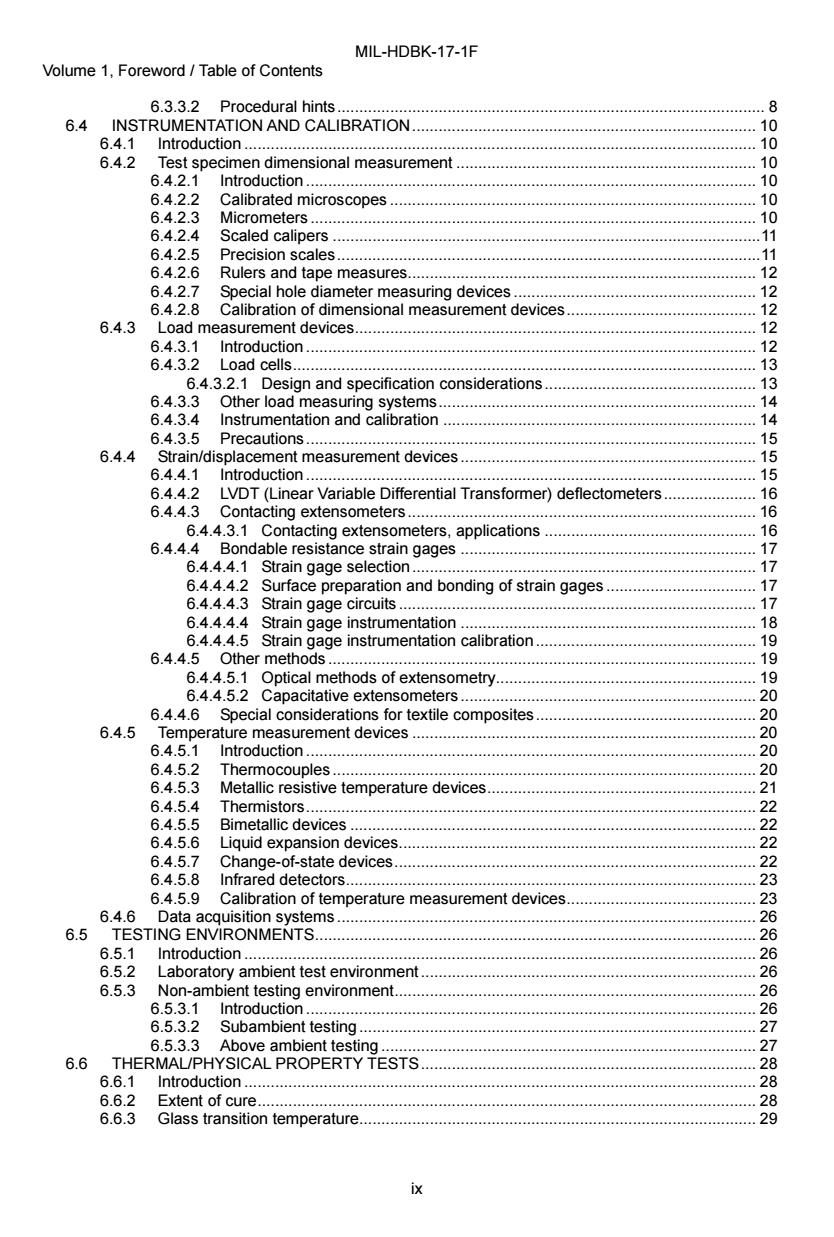
MIL-HDBK-17-1F Volume 1,Foreword Table of Contents 6.3.3.2 Procedural hints....... .8 6.4 INSTRUMENTATION AND CALIBRATION.............. 10 6.4.1 Introduction.. 10 6.4.2 Test specimen dimensional measurement............ 10 6.4.2.1 Introduction.10 6.4.2.2 Calibrated microscopes............. 10 6.4.2.3 Micrometers. 10 6.4.2.4 Scaled calipers.....................1 6.4.2.5 PreciSion Scales.. 6.4.2.6 Rulers and tape measures..... 12 6.4.2.7 Special hole diameter measuring devices..................12 6.4.2.8 Calibration of dimensional measurement devices.......... 12 6.4.3 Load measurement devices......................... 12 6.4.3.1 Introduction.. 12 6.4.3.2 2 Load cells..... 13 6.4.3.2.1 Design and specification considerations........................13 6.4.3.3 Other load measuring systems..... .14 6.4.3.4 Instrumentation and calibration ..14 6.4.3.5 Precautions… 15 6.4.4 Strain/displacement measurement devices...................................15 6.4.4.1 Introduction. 4444444444 .15 6.4.4.2 LVDT(Linear Variable Differential Transformer)deflectometers..... 16 6.4.4.3 Contacting extensometers................. 16 6.4.4.3.1 Contacting extensometers,applications...... 16 6.4.4.4 Bondable resistance strain gages 17 6.4.4.4.1 Strain gage selection..... .17 6.4.4.4.2 Surface preparation and bonding of strain gages................................1.7 6.4.4.4.3 Strain gage circuits.17 6.4.4.4.4 Strain gage instrumentation.... 18 6.4.4.4.5 Strain gage instrumentation calibration....... 19 6.4.4.5 Other methods..... 19 6.4.4.5.1 Optical methods of extensometry............................. 19 6.4.4.5.2 Capacitative extensometers........ 20 6.4.4.6 Special considerations for textile composites.................................... 20 6.4.5 Temperature measurement devices. 20 6.4.5.1 htroducton............................................................................. 20 6.4.5.2 Thermocouples.................... 20 6.4.5.3 Metallic resistive temperature devices... 21 6.4.5.4 Thermistors....... 22 6.4.5.5 Bimetallic devices..... 22 6.4.5.6 Liquid expansion devices............ 22 6.4.5.7 Change-of-state devices. 22 6.4.5.8 Infrared detectors................ 23 6.4.5.9 Calibration of temperature measurement devices........................................... 23 6.4.6 Data acquisition systems..... 26 6.5 TESTING ENVIRONMENTS................. 26 6.5.1 Introduction..… 26 6.5.2 Laboratory ambient test environment..... 26 6.5.3 Non-ambient testing environment............ 26 6.5.3.1 Introduction...... 26 6.5.3.2 Subambient testing.… 27 6.5.3.3 Above ambient testing.. 27 6.6 THERMAL/PHYSICAL PROPERTY TESTS 444444444444444 28 6.6.1 Introduction .... 28 6.6.2 Extent of cure............ 28 6.6.3 Glass transition temperature.............. .29
MIL-HDBK-17-1F Volume 1, Foreword / Table of Contents ix 6.3.3.2 Procedural hints................................................................................................. 8 6.4 INSTRUMENTATION AND CALIBRATION.............................................................................. 10 6.4.1 Introduction .................................................................................................................... 10 6.4.2 Test specimen dimensional measurement .................................................................... 10 6.4.2.1 Introduction ...................................................................................................... 10 6.4.2.2 Calibrated microscopes ................................................................................... 10 6.4.2.3 Micrometers..................................................................................................... 10 6.4.2.4 Scaled calipers .................................................................................................11 6.4.2.5 Precision scales................................................................................................11 6.4.2.6 Rulers and tape measures............................................................................... 12 6.4.2.7 Special hole diameter measuring devices ....................................................... 12 6.4.2.8 Calibration of dimensional measurement devices........................................... 12 6.4.3 Load measurement devices........................................................................................... 12 6.4.3.1 Introduction ...................................................................................................... 12 6.4.3.2 Load cells......................................................................................................... 13 6.4.3.2.1 Design and specification considerations................................................ 13 6.4.3.3 Other load measuring systems........................................................................ 14 6.4.3.4 Instrumentation and calibration ....................................................................... 14 6.4.3.5 Precautions...................................................................................................... 15 6.4.4 Strain/displacement measurement devices................................................................... 15 6.4.4.1 Introduction ...................................................................................................... 15 6.4.4.2 LVDT (Linear Variable Differential Transformer) deflectometers..................... 16 6.4.4.3 Contacting extensometers............................................................................... 16 6.4.4.3.1 Contacting extensometers, applications ................................................ 16 6.4.4.4 Bondable resistance strain gages ................................................................... 17 6.4.4.4.1 Strain gage selection.............................................................................. 17 6.4.4.4.2 Surface preparation and bonding of strain gages .................................. 17 6.4.4.4.3 Strain gage circuits................................................................................. 17 6.4.4.4.4 Strain gage instrumentation ................................................................... 18 6.4.4.4.5 Strain gage instrumentation calibration.................................................. 19 6.4.4.5 Other methods................................................................................................. 19 6.4.4.5.1 Optical methods of extensometry........................................................... 19 6.4.4.5.2 Capacitative extensometers................................................................... 20 6.4.4.6 Special considerations for textile composites.................................................. 20 6.4.5 Temperature measurement devices .............................................................................. 20 6.4.5.1 Introduction ...................................................................................................... 20 6.4.5.2 Thermocouples................................................................................................ 20 6.4.5.3 Metallic resistive temperature devices............................................................. 21 6.4.5.4 Thermistors...................................................................................................... 22 6.4.5.5 Bimetallic devices ............................................................................................ 22 6.4.5.6 Liquid expansion devices................................................................................. 22 6.4.5.7 Change-of-state devices.................................................................................. 22 6.4.5.8 Infrared detectors............................................................................................. 23 6.4.5.9 Calibration of temperature measurement devices........................................... 23 6.4.6 Data acquisition systems............................................................................................... 26 6.5 TESTING ENVIRONMENTS.................................................................................................... 26 6.5.1 Introduction .................................................................................................................... 26 6.5.2 Laboratory ambient test environment ............................................................................ 26 6.5.3 Non-ambient testing environment.................................................................................. 26 6.5.3.1 Introduction ...................................................................................................... 26 6.5.3.2 Subambient testing.......................................................................................... 27 6.5.3.3 Above ambient testing ..................................................................................... 27 6.6 THERMAL/PHYSICAL PROPERTY TESTS............................................................................ 28 6.6.1 Introduction .................................................................................................................... 28 6.6.2 Extent of cure................................................................................................................. 28 6.6.3 Glass transition temperature.......................................................................................... 29

MIL-HDBK-17-1F Volume 1,Foreword Table of Contents 6.6.3.1 ○verview....... 29 6.6.3.2 T.Measurements 29 6.6.3.2.1 Differential scanning calorimetry (DSC).................... 29 6.6.3.2.2 Thermomechanical analysis (TMA)................................................. 30 6.6.3.2.3 Dynamic mechanical analysis (DMA)...32 6.6.3.3 Glass transition test methods for MIL-HDBK-17 data submittal......... 33 6.6.3.4 Crystalline melt temperature..... 33 6.6.4 Density..... 34 6.6.4.1 Overview....... 34 6.6.4.2 ASTM D 792,Standard Test Method for Density and Specific Gravity (Relative Density)of Plastics by Displacement............. .34 6.6.4.3 ASTM D 1505,Standard Test Method for Density of Plastics by the Density-Gradient Technique.................... .35 6.6.4.4 Use of helium pycnometry to determine density of composites......................36 6.6.4.4.1 Helium pycnometry test procedure for determining composite density..... 38 6.6.4.5 Summary of helium pycnometry experimental results. ..39 6.6.4.6 Density test methods for MIL-HDBK-17 data submittal.................................. 40 6.6.5 Cured ply thickness 40 6.6.5.1 Overview......... 41 6.6.5.2 Thickness measurement using direct means...................................41 6.6.5.3 Thickness measurement using indirect means... 41 6.6.5.4 SRM 10R-94,SACMA Recommended Method for Fiber Volume Percent Resin Volume and Calculated Average Cured Ply Thickness of Plied Laminates..... 42 6.6.5.5 Cured ply thickness test methods for MIL-HDBK-17 data submittal .............42 6.6.6 Fiber volume (V fraction............... 2 6.6.6.1 Introduction.… 42 6.6.6.2 Matrix digestion.... 42 6.6.6.3 Igniti0nl0SS.… 43 6.6.6.4 Areal weight/thickness.... 43 6.6.6.5 Determination of fiber volume using image analysis................................. 45 6.6.6.5.1 Background..... 45 6.6.6.5.2 Apparatus......................................................................................... 45 6.6.6.5.3 Specimen preparation. 45 6.6.6.5.4 Image analysis...... 46 6.6.6.5.5 Sources of error.... 47 6.6.7 Void volume (V)fraction......... 48 6.6.7.1 Introduction......... 48 6.6.7.2 Digestive evaluation...... 48 6.6.7.3 Determination of void volume using image analysis 49 6.6.7.3.1 Background. 49 6.6.78.2 Sources of Error................... 50 6.6.8 Moisture/diffusivity 52 6.6.8.1 Standard test methods......... 53 6.6.8.2 Moisture diffusion property test methods for MIL-HDBK-17 data submittal... 54 6.6.9 Dimensional stability (Thermal and Moisture).........................................54 6.6.9.1 Dimensional stability(thermal)…. 55 6.6.9.1.1 Introduction. 55 6.6.9.1.2 Existing test methods. 55 6.6.9.1.3 Test specimens..... 56 6.6.9.1.4 Test apparatus and instrumentation........ 57 6.6.9.1.5 CTE test methods for MIL-HDBK-17 data submittal .............................57 6.6.9.2 Dimensional stability (moisture). 58 6.6.8.2.1 Introduction. .58
MIL-HDBK-17-1F Volume 1, Foreword / Table of Contents x 6.6.3.1 Overview.......................................................................................................... 29 6.6.3.2 Tg Measurements............................................................................................. 29 6.6.3.2.1 Differential scanning calorimetry (DSC) ................................................. 29 6.6.3.2.2 Thermomechanical analysis (TMA)........................................................ 30 6.6.3.2.3 Dynamic mechanical analysis (DMA)..................................................... 32 6.6.3.3 Glass transition test methods for MIL-HDBK-17 data submittal...................... 33 6.6.3.4 Crystalline melt temperature............................................................................ 33 6.6.4 Density........................................................................................................................... 34 6.6.4.1 Overview.......................................................................................................... 34 6.6.4.2 ASTM D 792, Standard Test Method for Density and Specific Gravity (Relative Density) of Plastics by Displacement ............................................... 34 6.6.4.3 ASTM D 1505, Standard Test Method for Density of Plastics by the Density-Gradient Technique ............................................................................ 35 6.6.4.4 Use of helium pycnometry to determine density of composites ...................... 36 6.6.4.4.1 Helium pycnometry test procedure for determining composite density .................................................................................................... 38 6.6.4.5 Summary of helium pycnometry experimental results..................................... 39 6.6.4.6 Density test methods for MIL-HDBK-17 data submittal................................... 40 6.6.5 Cured ply thickness ....................................................................................................... 40 6.6.5.1 Overview.......................................................................................................... 41 6.6.5.2 Thickness measurement using direct means .................................................. 41 6.6.5.3 Thickness measurement using indirect means ............................................... 41 6.6.5.4 SRM 10R-94, SACMA Recommended Method for Fiber Volume, Percent Resin Volume and Calculated Average Cured Ply Thickness of Plied Laminates ............................................................................................... 42 6.6.5.5 Cured ply thickness test methods for MIL-HDBK-17 data submittal ............... 42 6.6.6 Fiber volume (Vf) fraction .............................................................................................. 42 6.6.6.1 Introduction ...................................................................................................... 42 6.6.6.2 Matrix digestion................................................................................................ 42 6.6.6.3 Ignition loss...................................................................................................... 43 6.6.6.4 Areal weight/thickness..................................................................................... 43 6.6.6.5 Determination of fiber volume using image analysis....................................... 45 6.6.6.5.1 Background ............................................................................................ 45 6.6.6.5.2 Apparatus ............................................................................................... 45 6.6.6.5.3 Specimen preparation ............................................................................ 45 6.6.6.5.4 Image analysis ....................................................................................... 46 6.6.6.5.5 Sources of error...................................................................................... 47 6.6.7 Void volume (Vv) fraction ............................................................................................... 48 6.6.7.1 Introduction ...................................................................................................... 48 6.6.7.2 Digestive evaluation......................................................................................... 48 6.6.7.3 Determination of void volume using image analysis ....................................... 49 6.6.7.3.1 Background ............................................................................................ 49 6.6.7.3.2 Sources of Error ..................................................................................... 50 6.6.8 Moisture/diffusivity ......................................................................................................... 52 6.6.8.1 Standard test methods..................................................................................... 53 6.6.8.2 Moisture diffusion property test methods for MIL-HDBK-17 data submittal........................................................................................................... 54 6.6.9 Dimensional stability (Thermal and Moisture) ............................................................... 54 6.6.9.1 Dimensional stability (thermal) ........................................................................ 55 6.6.9.1.1 Introduction............................................................................................. 55 6.6.9.1.2 Existing test methods ............................................................................. 55 6.6.9.1.3 Test specimens....................................................................................... 56 6.6.9.1.4 Test apparatus and instrumentation ....................................................... 57 6.6.9.1.5 CTE test methods for MIL-HDBK-17 data submittal .............................. 57 6.6.9.2 Dimensional stability (moisture)....................................................................... 58 6.6.9.2.1 Introduction............................................................................................. 58
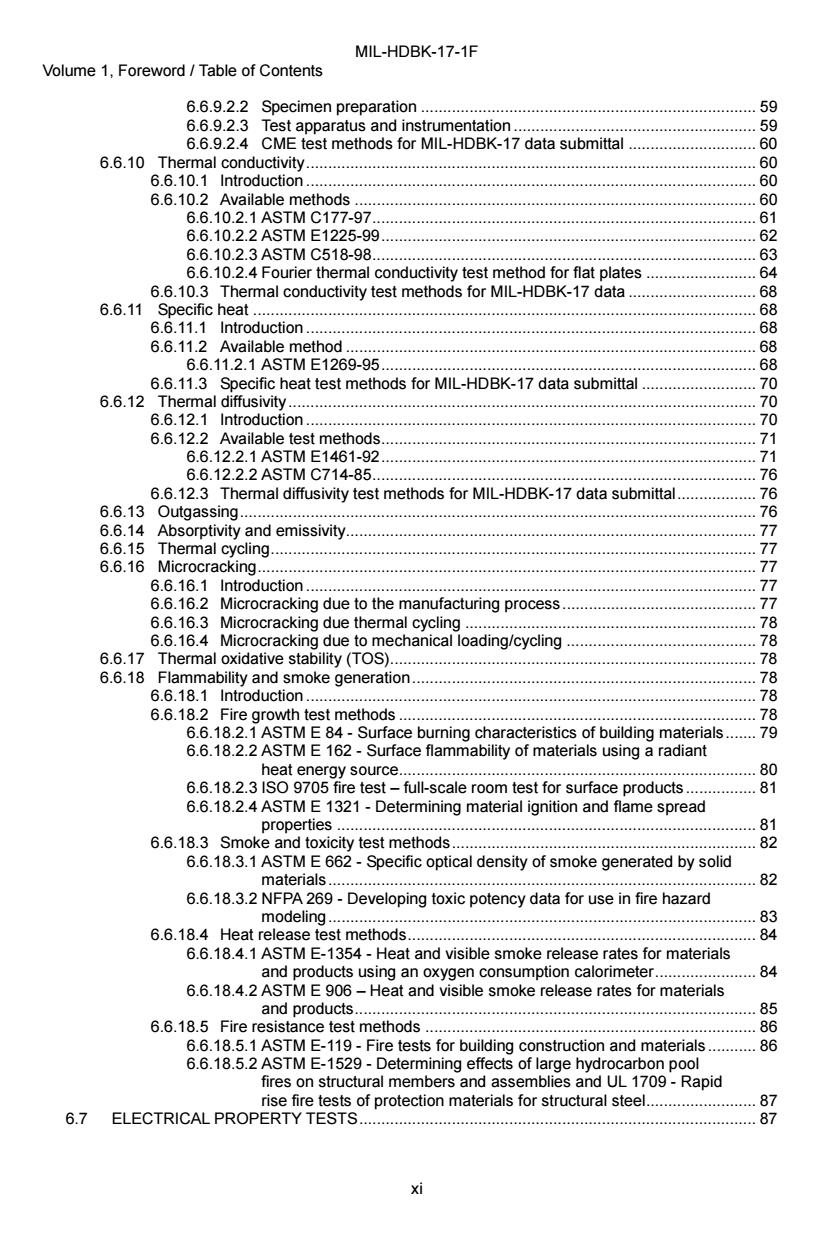
MIL-HDBK-17-1F Volume 1,Foreword /Table of Contents 6.6.9.2.2 Specimen preparation.......... 59 6.6.9.2.3 Test apparatus and instrumentation.............. 59 6.6.9.2.4 CME test methods for MIL-HDBK-17 data submittal ........................... 60 6.6.10 Thermal conductivity.. 60 6.6.10.1 Introduction.. 60 6.6.10.2 Available methods.... 60 6.6.10.2.1 ASTM C177-97. 61 6.6.10.2.2 ASTM E1225-99 62 6.6.10.2.3 ASTM C518-98. 63 6.6.10.2.4 Fourier thermal conductivity test method for flat plates... 64 6.6.10.3 Thermal conductivity test methods for MIL-HDBK-17 data........................... 68 6.6.11 Specific heat… 68 6.6.11.1lntr0 ductic0n....................68 6.6.11.2 Available method. 68 6.6.11.2.1 ASTM E1269-95. 68 6.6.11.3 Specific heat test methods for MIL-HDBK-17 data submittal 70 6.6.12 Thermal diffusivity...... 70 6.6.12.1 Introduction........... 70 6.6.12.2 Available test methods. 71 6.6.12.2.1 ASTM E1461-92........71 6.6.12.2.2 ASTM C714-85.… 76 6.6.12.3 Thermal diffusivity test methods for MIL-HDBK-17 data submittal. 76 6.6.13 Outgassing... 76 6.6.14 Absorptivity and emissivity..... 77 6.6.15 Thermal cycling.… 77 6.6.16 Microcracking....... 77 6.6.16.1 Introduction....... 77 6.6.16.2 Microcracking due to the manufacturing process.......................... 77 6.6.16.3 Microcracking due thermal cycling.... 78 6.6.16.4 Microcracking due to mechanical loading/cycling .......................................... 78 6.6.17 Thermal oxidative stability (TOS)........ 78 6.6.18 Flammability and smoke generation.. 78 6.6.18.1 Introduction....... 78 6.6.18.2 Fire growth test methods.............................. 78 6.6.18.2.1 ASTM E 84-Surface burning characteristics of building materials.......79 6.6.18.2.2 ASTM E 162-Surface flammability of materials using a radiant heat energy source.... 80 6.6.18.2.3 ISO 9705 fire test-full-scale room test for surface products... .81 6.6.18.2.4 ASTM E 1321-Determining material ignition and flame spread properties..... .81 6.6.18.3 Smoke and toxicity test methods...... ...82 6.6.18.3.1 ASTM E 662-Specific optical density of smoke generated by solid materials................... ..82 6.6.18.3.2 NFPA 269-Developing toxic potency data for use in fire hazard modeling..… .83 6.6.18.4 Heat release test methods....... .84 6.6.18.4.1 ASTM E-1354-Heat and visible smoke release rates for materials and products using an oxygen consumption calorimeter.......................84 6.6.18.4.2 ASTM E 906-Heat and visible smoke release rates for materials and products.......... ...85 6.6.18.5 Fire resistance test methods... 86 6.6.18.5.1 ASTM E-119-Fire tests for building construction and materials...........86 6.6.18.5.2 ASTM E-1529-Determining effects of large hydrocarbon pool fires on structural members and assemblies and UL 1709-Rapid rise fire tests of protection materials for structural steel........................87 6.7 ELECTRICAL PROPERTYTESTS........87 xi
MIL-HDBK-17-1F Volume 1, Foreword / Table of Contents xi 6.6.9.2.2 Specimen preparation ............................................................................ 59 6.6.9.2.3 Test apparatus and instrumentation ....................................................... 59 6.6.9.2.4 CME test methods for MIL-HDBK-17 data submittal ............................. 60 6.6.10 Thermal conductivity...................................................................................................... 60 6.6.10.1 Introduction ...................................................................................................... 60 6.6.10.2 Available methods ........................................................................................... 60 6.6.10.2.1 ASTM C177-97....................................................................................... 61 6.6.10.2.2 ASTM E1225-99..................................................................................... 62 6.6.10.2.3 ASTM C518-98....................................................................................... 63 6.6.10.2.4 Fourier thermal conductivity test method for flat plates ......................... 64 6.6.10.3 Thermal conductivity test methods for MIL-HDBK-17 data ............................. 68 6.6.11 Specific heat .................................................................................................................. 68 6.6.11.1 Introduction ...................................................................................................... 68 6.6.11.2 Available method ............................................................................................. 68 6.6.11.2.1 ASTM E1269-95..................................................................................... 68 6.6.11.3 Specific heat test methods for MIL-HDBK-17 data submittal .......................... 70 6.6.12 Thermal diffusivity.......................................................................................................... 70 6.6.12.1 Introduction ...................................................................................................... 70 6.6.12.2 Available test methods..................................................................................... 71 6.6.12.2.1 ASTM E1461-92..................................................................................... 71 6.6.12.2.2 ASTM C714-85....................................................................................... 76 6.6.12.3 Thermal diffusivity test methods for MIL-HDBK-17 data submittal.................. 76 6.6.13 Outgassing..................................................................................................................... 76 6.6.14 Absorptivity and emissivity............................................................................................. 77 6.6.15 Thermal cycling.............................................................................................................. 77 6.6.16 Microcracking................................................................................................................. 77 6.6.16.1 Introduction ...................................................................................................... 77 6.6.16.2 Microcracking due to the manufacturing process............................................ 77 6.6.16.3 Microcracking due thermal cycling .................................................................. 78 6.6.16.4 Microcracking due to mechanical loading/cycling ........................................... 78 6.6.17 Thermal oxidative stability (TOS)................................................................................... 78 6.6.18 Flammability and smoke generation.............................................................................. 78 6.6.18.1 Introduction ...................................................................................................... 78 6.6.18.2 Fire growth test methods ................................................................................. 78 6.6.18.2.1 ASTM E 84 - Surface burning characteristics of building materials....... 79 6.6.18.2.2 ASTM E 162 - Surface flammability of materials using a radiant heat energy source................................................................................. 80 6.6.18.2.3 ISO 9705 fire test – full-scale room test for surface products................ 81 6.6.18.2.4 ASTM E 1321 - Determining material ignition and flame spread properties ............................................................................................... 81 6.6.18.3 Smoke and toxicity test methods..................................................................... 82 6.6.18.3.1 ASTM E 662 - Specific optical density of smoke generated by solid materials................................................................................................. 82 6.6.18.3.2 NFPA 269 - Developing toxic potency data for use in fire hazard modeling................................................................................................. 83 6.6.18.4 Heat release test methods............................................................................... 84 6.6.18.4.1 ASTM E-1354 - Heat and visible smoke release rates for materials and products using an oxygen consumption calorimeter....................... 84 6.6.18.4.2 ASTM E 906 – Heat and visible smoke release rates for materials and products........................................................................................... 85 6.6.18.5 Fire resistance test methods ........................................................................... 86 6.6.18.5.1 ASTM E-119 - Fire tests for building construction and materials........... 86 6.6.18.5.2 ASTM E-1529 - Determining effects of large hydrocarbon pool fires on structural members and assemblies and UL 1709 - Rapid rise fire tests of protection materials for structural steel......................... 87 6.7 ELECTRICAL PROPERTY TESTS.......................................................................................... 87
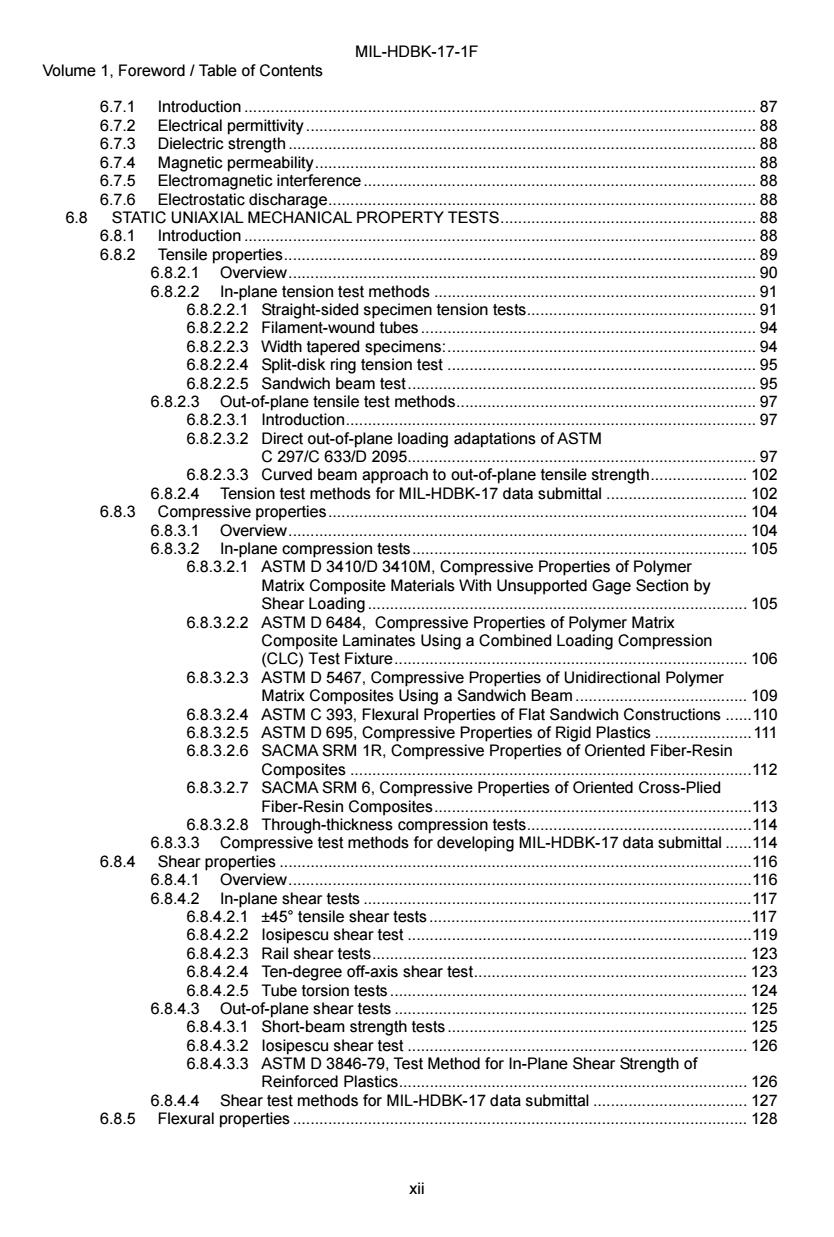
MIL-HDBK-17-1F Volume 1,Foreword Table of Contents 6.7.1 Introduction................... 87 6.7.2 Electrical permittivity 88 6.7.3 Dielectric strength....... 88 6.7.4 Magnetic permeability............... .88 6.7.5 Electromagnetic interference. 88 6.76 Electrostatic discharage...... 88 6.8 STATIC UNIAXIAL MECHANICAL PROPERTY TESTS. 88 6.8.1 Introduction........ 88 6.8.2 Tensile properties.… 89 6.8.2.1 Overview.... 90 6.8.2.2 In-plane tension test methods........ .91 6.8.2.2.1 Straight-sided specimen tension tests... .91 6.8.2.2.2 Filament-wound tubes...94 6.8.2.2.3 Width tapered specimens: 94 6.8.2.2.4 Split-disk ring tension test 95 6.8.2.2.5 Sandwich beam test..................... 95 6.8.2.3 Out-of-plane tensile test methods........ .97 6.8.2.3.1 Introduction.......... ...97 6.8.2.3.2 Direct out-of-plane loading adaptations of ASTM C297/C633/D2095....... .97 6.8.2.3.3 Curved beam approach to out-of-plane tensile strength..................102 6.8.2.4 Tension test methods for MIL-HDBK-17 data submittal ...... 102 6.8.3 Compressive properties.. 104 6.8.3.1 Overview.......... 104 6.8.3.2 In-plane compression tests.... 105 6.8.3.2.1 ASTM D 3410/D 3410M,Compressive Properties of Polymer Matrix Composite Materials With Unsupported Gage Section by Shear Loading........................ 105 6.8.3.2.2 ASTM D 6484,Compressive Properties of Polymer Matrix Composite Laminates Using a Combined Loading Compression (CLC)Test Fixture........... ..106 6.8.3.2.3 ASTM D 5467,Compressive Properties of Unidirectional Polymer Matrix Composites Using a Sandwich Beam....... .109 6.8.3.2.4 ASTM C 393,Flexural Properties of Flat Sandwich Constructions......110 6.8.3.2.5 ASTM D 695,Compressive Properties of Rigid Plastics......................111 6.8.3.2.6 SACMA SRM 1R,Compressive Properties of Oriented Fiber-Resin Composites..... .112 6.8.3.2.7 SACMA SRM 6,Compressive Properties of Oriented Cross-Plied Fiber-Resin Composites............ .113 6.8.3.2.8 Through-thickness compression tests.... .114 6.8.3.3 Compressive test methods for developing MIL-HDBK-17 data submittal......114 6.8.4 Shear properties.116 6.8.4.1 Overview........... 116 6.8.4.2 In-plane shear tests.....117 6.8.4.2.1t45°tensile shear tests.… .117 6.8.4.2.2 losipescu shear test. .119 6.8.4.2.3 Rail shear tests....................... 123 6.8.4.2.4 Ten-degree off-axis shear test.....123 6.8.4.2.5 Tube torsion tests.. 124 6.8.4.3 Out-of-plane shear tests........ 125 6.8.4.3.1 Short-beam strength tests. 125 6.8.4.3.2 losipescu shear test.... 126 6.8.4.3.3 ASTM D 3846-79,Test Method for In-Plane Shear Strength of Reinforced Plastics.... 126 6.8.4.4 Shear test methods for MIL-HDBK-17 data submittal ................................ 127 6.8.5 Flexural properties 128 xii
MIL-HDBK-17-1F Volume 1, Foreword / Table of Contents xii 6.7.1 Introduction .................................................................................................................... 87 6.7.2 Electrical permittivity...................................................................................................... 88 6.7.3 Dielectric strength .......................................................................................................... 88 6.7.4 Magnetic permeability.................................................................................................... 88 6.7.5 Electromagnetic interference......................................................................................... 88 6.7.6 Electrostatic discharage................................................................................................. 88 6.8 STATIC UNIAXIAL MECHANICAL PROPERTY TESTS.......................................................... 88 6.8.1 Introduction .................................................................................................................... 88 6.8.2 Tensile properties........................................................................................................... 89 6.8.2.1 Overview.......................................................................................................... 90 6.8.2.2 In-plane tension test methods ......................................................................... 91 6.8.2.2.1 Straight-sided specimen tension tests.................................................... 91 6.8.2.2.2 Filament-wound tubes............................................................................ 94 6.8.2.2.3 Width tapered specimens:...................................................................... 94 6.8.2.2.4 Split-disk ring tension test ...................................................................... 95 6.8.2.2.5 Sandwich beam test............................................................................... 95 6.8.2.3 Out-of-plane tensile test methods.................................................................... 97 6.8.2.3.1 Introduction............................................................................................. 97 6.8.2.3.2 Direct out-of-plane loading adaptations of ASTM C 297/C 633/D 2095............................................................................... 97 6.8.2.3.3 Curved beam approach to out-of-plane tensile strength...................... 102 6.8.2.4 Tension test methods for MIL-HDBK-17 data submittal ................................ 102 6.8.3 Compressive properties............................................................................................... 104 6.8.3.1 Overview........................................................................................................ 104 6.8.3.2 In-plane compression tests............................................................................ 105 6.8.3.2.1 ASTM D 3410/D 3410M, Compressive Properties of Polymer Matrix Composite Materials With Unsupported Gage Section by Shear Loading ...................................................................................... 105 6.8.3.2.2 ASTM D 6484, Compressive Properties of Polymer Matrix Composite Laminates Using a Combined Loading Compression (CLC) Test Fixture................................................................................ 106 6.8.3.2.3 ASTM D 5467, Compressive Properties of Unidirectional Polymer Matrix Composites Using a Sandwich Beam ....................................... 109 6.8.3.2.4 ASTM C 393, Flexural Properties of Flat Sandwich Constructions ......110 6.8.3.2.5 ASTM D 695, Compressive Properties of Rigid Plastics ......................111 6.8.3.2.6 SACMA SRM 1R, Compressive Properties of Oriented Fiber-Resin Composites ...........................................................................................112 6.8.3.2.7 SACMA SRM 6, Compressive Properties of Oriented Cross-Plied Fiber-Resin Composites........................................................................113 6.8.3.2.8 Through-thickness compression tests...................................................114 6.8.3.3 Compressive test methods for developing MIL-HDBK-17 data submittal ......114 6.8.4 Shear properties ...........................................................................................................116 6.8.4.1 Overview.........................................................................................................116 6.8.4.2 In-plane shear tests ........................................................................................117 6.8.4.2.1 ±45° tensile shear tests.........................................................................117 6.8.4.2.2 Iosipescu shear test ..............................................................................119 6.8.4.2.3 Rail shear tests..................................................................................... 123 6.8.4.2.4 Ten-degree off-axis shear test.............................................................. 123 6.8.4.2.5 Tube torsion tests................................................................................. 124 6.8.4.3 Out-of-plane shear tests ................................................................................ 125 6.8.4.3.1 Short-beam strength tests.................................................................... 125 6.8.4.3.2 Iosipescu shear test ............................................................................. 126 6.8.4.3.3 ASTM D 3846-79, Test Method for In-Plane Shear Strength of Reinforced Plastics............................................................................... 126 6.8.4.4 Shear test methods for MIL-HDBK-17 data submittal ................................... 127 6.8.5 Flexural properties ....................................................................................................... 128